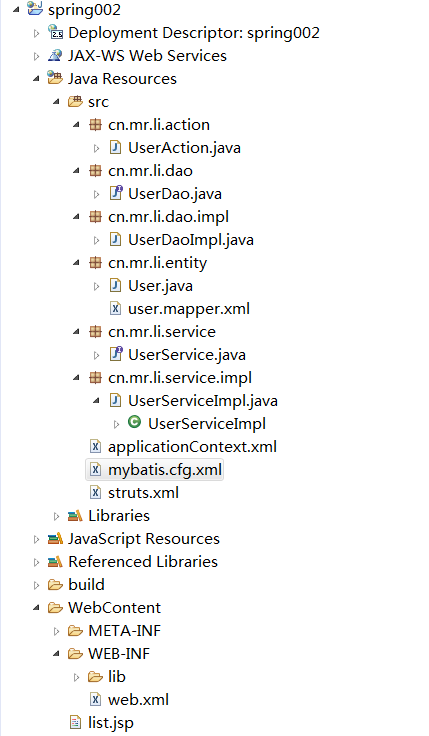和xml版差不多,只不过创建对象的方式是由spring自动扫描包名,然后命名空间多一行context代码在application.xml中,然后将每个对象通过注解创建和注入:
直接上代码:
1.userDao
package cn.mr.li.dao; import java.util.List; import cn.mr.li.entity.User; public interface UserDao { List<User> getUser(); }
2.userDaoImpl
package cn.mr.li.dao.impl; import java.util.List; import org.apache.ibatis.session.SqlSessionFactory; import org.mybatis.spring.support.SqlSessionDaoSupport; import org.springframework.beans.factory.annotation.Autowired; import org.springframework.stereotype.Repository; import cn.mr.li.dao.UserDao; import cn.mr.li.entity.User; /** * 因为直接调用的都是Service接口类型,不直接注入impl实现类,所以不用写@Repository("userDao")@Service("userService")这样的 * @author Administrator * */ @Repository() public class UserDaoImpl extends SqlSessionDaoSupport implements UserDao { @Autowired @Override public void setSqlSessionFactory(SqlSessionFactory sqlSessionFactory) { super.setSqlSessionFactory(sqlSessionFactory); } @Override public List<User> getUser() { return this.getSqlSession().selectList("cn.mr.li.entity.user.mapper.getAll"); } }
3.userService
package cn.mr.li.service; import java.util.List; import cn.mr.li.entity.User; public interface UserService { List<User> getAll(); }
4.userServiceImpl
package cn.mr.li.service.impl; import java.util.List; import org.springframework.beans.factory.annotation.Autowired; import org.springframework.stereotype.Service; import cn.mr.li.dao.UserDao; import cn.mr.li.entity.User; import cn.mr.li.service.UserService; @Service() public class UserServiceImpl implements UserService { @Autowired private UserDao userDao; @Override public List<User> getAll() { return userDao.getUser(); } public UserDao getUserDao() { return userDao; } public void setUserDao(UserDao userDao) { this.userDao = userDao; } }
5.user对象
package cn.mr.li.entity; public class User { private int id; private String name; private int age; public int getId() { return id; } public void setId(int id) { this.id = id; } public String getName() { return name; } public void setName(String name) { this.name = name; } public int getAge() { return age; } public void setAge(int age) { this.age = age; } public User(int id, String name, int age) { super(); this.id = id; this.name = name; this.age = age; } public User() { } }
6.user.mapper.xml
<?xml version="1.0" encoding="UTF-8"?> <!DOCTYPE mapper PUBLIC "-//mybatis.org//DTD Mapper 3.0//EN" "http://mybatis.org/dtd/mybatis-3-mapper.dtd"> <mapper namespace="cn.mr.li.entity.user.mapper"> <select id="getAll" resultType="User"> select * from user </select> </mapper>
7.userAction
package cn.mr.li.action; import java.util.List; import org.springframework.beans.factory.annotation.Autowired; import org.springframework.context.annotation.Scope; import org.springframework.stereotype.Controller; import cn.mr.li.entity.User; import cn.mr.li.service.UserService; /** *@Scope注解的意思是为了配置让每个被访问的Action都不是单例的,否则本次访问到下次在访问,上次的数据就会还存在。 * @author Administrator * */ @Controller() @Scope("prototype") public class UserAction { private List<User> list; @Autowired private UserService userService; /** * 这里必须返回success,因为访问的时候回判断状态,如果不是success让数据不予扎实,页面就会404 * @return */ public String list(){ list = userService.getAll(); return "success"; } public List<User> getList() { return list; } }
8.applicationContext.xml
<?xml version="1.0" encoding="UTF-8"?> <beans xmlns="http://www.springframework.org/schema/beans" xmlns:xsi="http://www.w3.org/2001/XMLSchema-instance" xmlns:aop="http://www.springframework.org/schema/aop" xmlns:tx="http://www.springframework.org/schema/tx" xmlns:context="http://www.springframework.org/schema/context" xsi:schemaLocation=" http://www.springframework.org/schema/beans http://www.springframework.org/schema/beans/spring-beans.xsd http://www.springframework.org/schema/aop http://www.springframework.org/schema/aop/spring-aop.xsd http://www.springframework.org/schema/tx http://www.springframework.org/schema/tx/spring-tx.xsd http://www.springframework.org/schema/context http://www.springframework.org/schema/context/spring-context.xsd"> <!-- 配置数据源 --> <bean id="dataSource" class="org.springframework.jdbc.datasource.DriverManagerDataSource"> <property name="driverClassName" value="com.mysql.jdbc.Driver"/> <property name="url" value="jdbc:mysql://localhost:3306/test"/> <property name="username" value="root"/> <property name="password" value="123456"/> </bean> <!-- 声明式事务配置 开始 --> <!-- 配置事务管理器 --> <bean id="txManager" class="org.springframework.jdbc.datasource.DataSourceTransactionManager"> <property name="dataSource" ref="dataSource"/> </bean> <!-- 配置事务通知 --> <tx:advice id="txAdvice" transaction-manager="txManager"> <tx:attributes> <!-- 配置哪些方法使用什么样的事务,配置事务的传播特性 --> <tx:method name="add" propagation="REQUIRED"/> <tx:method name="insert" propagation="REQUIRED"/> <tx:method name="update" propagation="REQUIRED"/> <tx:method name="delete" propagation="REQUIRED"/> <tx:method name="remove*" propagation="REQUIRED"/> <tx:method name="get" read-only="true"/> <tx:method name="*" propagation="REQUIRED"/> </tx:attributes> </tx:advice> <aop:config> <aop:pointcut expression="execution(* cn.mr.li.service.impl.*.*(..))" id="pointcut"/> <aop:advisor advice-ref="txAdvice" pointcut-ref="pointcut"/> </aop:config> <!-- 声明式事务配置 结束 --> <!-- 配置sqlSessionFactory --> <bean id="sqlSessionFactory" class="org.mybatis.spring.SqlSessionFactoryBean"> <property name="dataSource" ref="dataSource"/> <property name="configLocation" value="classpath:mybatis.cfg.xml"></property> </bean> <!-- spring启动之初会自动扫描该包下的所有类文件 --> <context:component-scan base-package="cn.mr.li"/> </beans>
9.mybatis.cfg.xml
<?xml version="1.0" encoding="UTF-8" ?> <!DOCTYPE configuration PUBLIC "-//mybatis.org//DTD Config 3.0//EN" "http://mybatis.org/dtd/mybatis-3-config.dtd"> <configuration> <typeAliases> <package name="cn.mr.li.entity"/> </typeAliases> <mappers> <mapper resource="cn/mr/li/entity/user.mapper.xml"/> </mappers> </configuration>s
10.struts.xml
<?xml version="1.0" encoding="UTF-8" ?> <!DOCTYPE struts PUBLIC "-//Apache Software Foundation//DTD Struts Configuration 2.3//EN" "http://struts.apache.org/dtds/struts-2.3.dtd"> <struts> <package name="user" namespace="/" extends="struts-default"> <!-- 此处配置的name="list",意思是在访问的时候可以通过list.去访问,至于.什么,是在web.xml 中的struts配置中配置的,本项目配置的是*.action所以就是,如果想访问本项目下的list.jsp页面的话 就直接在父路径(默认是项目名)后跟 /list.action --> <action name="list" class="userAction" method="list"> <result>/list.jsp</result> </action> </package> </struts>
11.web.xml
<?xml version="1.0" encoding="UTF-8"?> <web-app xmlns:xsi="http://www.w3.org/2001/XMLSchema-instance" xmlns="http://java.sun.com/xml/ns/javaee" xmlns:web="http://java.sun.com/xml/ns/javaee/web-app_2_5.xsd" xsi:schemaLocation="http://java.sun.com/xml/ns/javaee http://java.sun.com/xml/ns/javaee/web-app_2_5.xsd" id="WebApp_ID" version="2.5"> <!-- 配置spring:配合全局变量,将由contextConfigLocation去读取spring得配置,不在需要在程序中读取了 --> <context-param> <param-name>contextConfigLocation</param-name> <param-value>classpath:applicationContext.xml</param-value> </context-param> <!-- 配置监听器:此监听器在启动初始化的时候在它的构造器中初始化全局上下文, 因此需要将spring的配置也加载进去,因为spring中有对象实例 --> <listener> <listener-class>org.springframework.web.context.ContextLoaderListener</listener-class> </listener> <!-- 配置struts2:需要配置过滤器,和它的url,访问样式 --> <filter> <filter-name>struts2</filter-name> <filter-class>org.apache.struts2.dispatcher.ng.filter.StrutsPrepareAndExecuteFilter</filter-class> </filter> <filter-mapping> <filter-name>struts2</filter-name> <!-- 访问时的后缀名就在这里设置了 --> <url-pattern>*.action</url-pattern> </filter-mapping> <welcome-file-list> <welcome-file>index.html</welcome-file> <welcome-file>index.htm</welcome-file> <welcome-file>index.jsp</welcome-file> <welcome-file>default.html</welcome-file> <welcome-file>default.htm</welcome-file> <welcome-file>default.jsp</welcome-file> </welcome-file-list> </web-app>
12.list.jsp
<%@ page language="java" import="java.util.*" pageEncoding="utf-8"%> <%@taglib prefix="c" uri="http://java.sun.com/jsp/jstl/core"%> <% String path = request.getContextPath(); String basePath = request.getScheme()+"://"+request.getServerName()+":"+request.getServerPort()+path+"/"; %> <!DOCTYPE HTML PUBLIC "-//W3C//DTD HTML 4.01 Transitional//EN"> <html> <head> <base href="<%=basePath%>"> <title>My JSP 'index.jsp' starting page</title> <meta http-equiv="pragma" content="no-cache"> <meta http-equiv="cache-control" content="no-cache"> <meta http-equiv="expires" content="0"> <meta http-equiv="keywords" content="keyword1,keyword2,keyword3"> <meta http-equiv="description" content="This is my page"> <!-- <link rel="stylesheet" type="text/css" href="styles.css"> --> </head> <body> <table width="80%" align="center"> <tr> <td>编号</td> <td>姓名</td> <td>密码</td> </tr> <c:forEach items="${list }" var="bean"> <tr> <td>${bean.id }</td> <td>${bean.name }</td> <td>${bean.age }</td> </tr> </c:forEach> </table> </body> </html>
我的访问路径:http://localhost:8080/spring001/list.action

项目目录结构:
